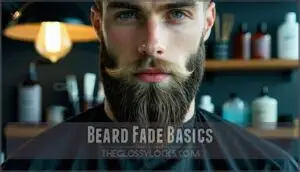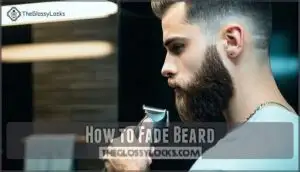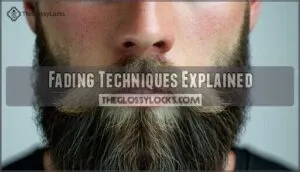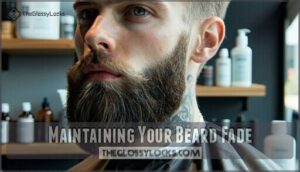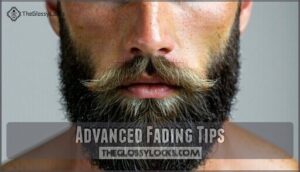This site is supported by our readers. We may earn a commission, at no cost to you, if you purchase through links.

Grab a trimmer with adjustable guards—those little snap-on attachments are your best friends here.
Begin with a larger guard size at the bottom of your beard, then gradually switch to smaller ones as you move up toward your cheeks.
Use smooth, steady strokes, blending the lengths for that seamless fade.
The goal is to create a natural progression—not look like you’ve just chopped chunks off.
Patience is key—don’t rush!
Once you’ve got your fade looking sharp, touch up your neckline and edges for extra polish.
Trust me, it’s worth it!
Table Of Contents
- Key Takeaways
- Beard Fade Basics
- How to Fade Beard
- Fading Techniques Explained
- Maintaining Your Beard Fade
- Common Mistakes to Avoid
- Advanced Fading Tips
- Frequently Asked Questions (FAQs)
- How can I fade my beard easily?
- How can I fade my beard color?
- What fade looks best with a beard?
- How do you taper fade a beard?
- How often should I trim my beard?
- What type of guard should I use for a fade?
- How do I know where to start fading my beard?
- What are the benefits of fading my beard?
- Are there any special techniques for fading my beard?
- How to choose a fade style for face shape?
- Conclusion
Key Takeaways
- Start with clean, dry facial hair and use clippers with adjustable guards, trimming gradually shorter as you go upward for a seamless fade.
- Focus on blending lengths smoothly, avoiding harsh lines and keeping strokes steady for balance and symmetry.
- Maintain your beard fade by trimming every few days, adjusting guard sizes as your beard grows to keep the fade sharp.
- Define the neckline and sideburns carefully, using natural curves and gradual fading for a clean, polished look.
Beard Fade Basics
A beard fade is all about blending longer hair into shorter lengths for a clean, polished look.
It’ll take your grooming game up a notch and keep your beard looking sharp without those awkward hard lines.
What is a Beard Fade
A beard fade blends hair gradually from shorter near your sideburns to longer along your jawline. It’s like a smooth highway exit for your beard, not a sharp cliff!
The perfect beard fade is like a smooth transition on a scenic road—seamless, sharp, and effortlessly stylish.
Perfect for clean, polished beard styles, fades work with any face shape.
- Adds a seamless shift to your look.
- Eliminates hard lines for a neat finish.
- Boosts your overall beard grooming impact.
Benefits of Fading Your Beard
Want your beard to stand out? A fading beard enhances your appearance by adding sharp facial definition and stylishly softened lines.
A fading beard sharpens your look with refined lines and a seamless blend, elevating your grooming to polished perfection.
It allows versatile styles while boosting manageability. Plus, a well-done beard fade elevates your grooming game, giving your beard aesthetics a polished look.
A great way to achieve this polished look is through fading the neckline. It’s like going from average to debonair—with just some clippers and care!
Tools Needed for Beard Fading
Achieving a great beard fade starts with the right tools—think precision, not guesswork.
Grab these must-haves:
- Beard clippers with adjustable guards for smooth blending.
- Beard combs to detangle and guide hair.
- Transparent shave gel for crisp lines.
- Trimmer recommendations like Wahl or Philips for precision.
- Outliner blades for tackling tricky edges.
Start sharp, stay sharp! Consider different clipper types for various beard lengths.
How to Fade Beard
Fading your beard might sound tricky, but it’s easier than you think with the right approach.
Grab your trimmer, pick the right guard, and let’s get that smooth, blended look you’ve been wanting!
Preparing Your Beard for Fading
Getting ready for a sharp beard fade means starting fresh.
Wash your beard to remove oil and debris, then detangle it with a comb to avoid snags.
Dry it completely—damp hair won’t trim evenly.
Finally, do a baseline trim for a clean canvas.
| Prep Step | Why It Matters | Tools Needed |
|---|---|---|
| Beard washing | Removes dirt buildup | Beard shampoo, water |
| Detangling beard | Prevents snags | Wide-tooth comb |
| Drying techniques | Makes certain of even trimming | Towel, blow dryer |
Choosing The Right Guard Size
Before you power up those clippers, understanding the Guard Size Guide is key.
Length guards dictate how short or full your fade appears. For a perfect blend, match the guard to your beard length.
Short fades (3mm-6mm) pop with sharp edges, while longer styles (10mm+) feel fuller.
Understanding available clipper sizes is essential for achieving the desired look. Stick with trusted clipper guard brands to avoid hiccups!
Trimming Techniques for a Smooth Fade
Once you’ve chosen your guard increments, it’s time to put those blending methods to work.
Start high on the cheeks with longer guards, moving downward gradually, use overlapping movements for smooth fading, avoiding sharp shifts.
For neckline fading and jawline definition, tread lightly—short passes prevent over-trimming.
Remember, beard trimming is about patience, a solid beard fade tutorial always emphasizes slow, deliberate steps.
Fading Techniques Explained
Fading your beard is all about blending different lengths smoothly for a clean, polished look.
Whether you’re trimming horizontally, vertically, or blending like a pro, mastering these techniques will level up your grooming game.
Horizontal Fading Method
Start your beard fade with the horizontal steps, trimming from the top lip to the sideburns. Use the largest guard first, steadily lower guard settings as you go. Many barbers use specific beard fade clippers for this purpose.
- Keep a steady hand for sideburn alignment.
- Follow the guard direction naturally to avoid patches.
- Blend evenly at each length.
- Focus on clean, sharp beard grooming for a polished look.
Vertical Fading Method
To use the vertical fading method, focus on blending direction using upward guard angles.
Trim small sections of hair vertically, adjusting guard lengths gradually. Work from your sideburns down toward your jawline.
This technique guarantees a smooth shift and balanced symmetry in your beard fade. Regular trims are essential to maintain a high fade’s gradient and overall look.
Patience is key—take it slow to perfect your beard grooming for polished, faded beard styles!
Blending Hair Lengths for a Natural Look
Let’s make those beard lines invisible! Once you’ve got the hang of vertical fading, the magic lies in gradual fading.
Start blending hair lengths step-by-step, using guards with small increments. Focus on softening lines for a seamless blend—no harsh edges allowed.
Remember, a natural appearance is your goal. Subtle, imperceptible blending keeps your beard fade looking sharp but effortlessly smooth.
Maintaining Your Beard Fade
Keeping your beard fade sharp takes regular trims and a bit of attention to detail.
Don’t skip on upkeep—letting it grow out too long can turn your sleek fade into a patchy mess.
Regular Trimming Schedule
Consistency is king when maintaining your beard fade.
Trim every 2-3 days to keep that fade looking sharp and perfectly blended. Growth impact varies, so adjust based on how fast your beard grows.
Integrate trims into your routine—think of it as a quick pitstop for your look! A solid beard fade guide helps nail this down with ease.
Regular trimming is essential to maintain the fade’s integrity, ensuring your beard always looks its best, with a well-maintained fade.
Adjusting Guard Sizes for Hair Growth
Keeping a beard fade sharp means adjusting guard sizes as your growth rate changes.
Faster growth might need tighter guard size progression, while slower growth allows more leniency.
For blending length variations, coarse hair guards handle bulk better, while fine hair fading benefits from lighter clippers.
Experiment to see what works best—your beard’s “Goldilocks zone” awaits in this beard cutting guide!
Common Mistakes to Avoid
It’s easy to mess up a beard fade if you’re not careful, but most mistakes are totally avoidable.
With the right tools, prep, and a bit of patience, you can dodge the common pitfalls and keep your fade looking sharp.
You can achieve this by following the given instructions carefully.
Using Wrong Tools for Fading
Using the wrong tools can ruin your beard fade dream faster than dull blades can snag your hair.
Stick to adjustable clippers, not scissors or outdated tools. A good fade means reliable gear, sharp blades, and proper guards.
- Avoid dull or rusty clippers.
- Skip scissor fading; it’s no good for blending.
- Invest in high-quality guards.
- Keep tools clean and maintained.
Improper Preparation and Patience
Skipping preparation is like cooking without reading the recipe—chaos.
Start with baseline trimming on a clean, dry beard.
Detangle it first; knots wreck fades.
Rushing results in patchy, uneven beard shaping.
Steady trimming is key, so slow down!
And don’t forget final brushing—it polishes everything up.
Grooming takes patience, but trust me, a smooth beard fade is worth it.
| Problem | Cause | Result | Solution |
|---|---|---|---|
| Skipping Detangling | Knotty beard mess | Uneven beard trimming | Detangle first! |
| Rushed Trimming | Lack of patience | Patchy beard fade | Trim steadily. |
| No Baseline Trim | Poor foundation | Inconsistent result | Start with prep. |
| Skipping Final Brush | Neglected finish | Messy, unpolished look | Brush to complete. |
Ignoring Regular Maintenance and Upkeep
Neglecting regular upkeep leaves your beard fade looking sloppy.
Trim every few days to keep fade longevity and shape retention intact.
Overgrown beards lead to style degradation, patchy growth, and even product buildup.
Grab your beard fade tools and stick to consistent beard fade maintenance. Don’t miss trims, or you’ll undo all those perfect beard fade techniques you worked hard on!
Advanced Fading Tips
Now that you’ve got the basics down, it’s time to tackle the advanced stuff that really makes your beard pop.
From nailing clean jawlines to perfecting your neckline, these pro-level tips will take your fade to the next level.
Fading Your Neckline and Cheeks
A flawless beard fade depends on perfecting your neckline and cheek definition.
Picture a clean curve under your jaw for the neckline shaping—trim from two fingers above the Adam’s apple.
For cheek lines, softly angle from sideburn to mustache, blending hair naturally.
Stick to gradual beard fade techniques, maintaining symmetry and avoiding patches for polished beard blending and smooth beard fade styles.
Creating a Defined Jawline and Sideburns
To craft a bold jawline and sideburn fade, start by trimming with precision.
Define your jawline by following its natural curve—angled or rounded, your call! Keep your sideburn styles clean and consistent for balance.
A faded beard enhances features and adds symmetry. For a seamless look, remember to blend lengths smoothly.
Trust me, good grooming’s impact is huge—your beard’s fade will turn heads effortlessly!
Frequently Asked Questions (FAQs)
How can I fade my beard easily?
Start with clippers and the biggest guard, trim gradually shorter as you move up.
Blend in small increments, focus on smooth shifts.
Go slow—rushing leads to oops moments.
Practice makes perfect, so don’t overthink it!
How can I fade my beard color?
Imagine painting a masterpiece—fading beard color is similar.
Use a semi-permanent dye, blending lighter tones into darker areas.
Apply carefully with a comb, rinse well, and voilà—balanced, natural shading with a polished touch!
What fade looks best with a beard?
A tapered fade that blends neatly from your sideburns into your beard works best.
It creates a sharp, clean look that highlights your jawline.
Just remember, a little patience turns a good trim into magic!
How do you taper fade a beard?
Think of a beard taper fade like shading a drawing.
Use clippers with adjustable guards, starting at your jawline with longer settings. Gradually switch to shorter guards as you move to sideburns.
Patience wins!
How often should I trim my beard?
Trim your beard every few days to keep it looking sharp and prevent things from getting scruffy.
If your beard grows slower, once a week works fine.
Regular upkeep saves time and keeps you looking polished.
What type of guard should I use for a fade?
Use larger guards (3-6) for the longer sections of your beard, then gradually switch to smaller guards (1-2) to taper down.
This keeps your fade smooth and avoids those choppy, uneven lines.
How do I know where to start fading my beard?
Start fading about an inch above your jawline.
Imagine painting with a brush—smooth, light strokes upward toward your sideburns.
Go slow, use a larger guard first, and blend gradually for that polished, seamless finish!
What are the benefits of fading my beard?
Fading your beard sharpens your overall look, giving you a clean, polished vibe.
It enhances your jawline, softens harsh lines, and makes your beard look intentional—like you woke up ready to conquer the day.
Are there any special techniques for fading my beard?
Picture your beard as a mountain range—tall peaks and gentle slopes.
To fade it, blend from longest to shortest using clipper guards.
Take it slow, work in sections, and embrace patience—it’s your beard’s masterpiece!
How to choose a fade style for face shape?
Pick a fade that highlights your best features.
Got a round face? Go for a tighter fade to sharpen your jawline.
Square face? Softer fades work wonders.
Experiment, and let your style speak!
Conclusion
Mastering how to fade your beard is like sculpting a masterpiece—precision, patience, and the right tools make all the difference.
With practice, you’ll create fades so smooth they’d make a barber proud.
Remember to start slow, blend carefully, and trust the process.
A sharp neckline and even shifts can transform your whole look.
Stick to your trimming routine, adjust for growth, and don’t stress over mistakes—they’re just part of learning.
Now, grab that trimmer and go rock your fade!
Trust the process and you will achieve great results.

